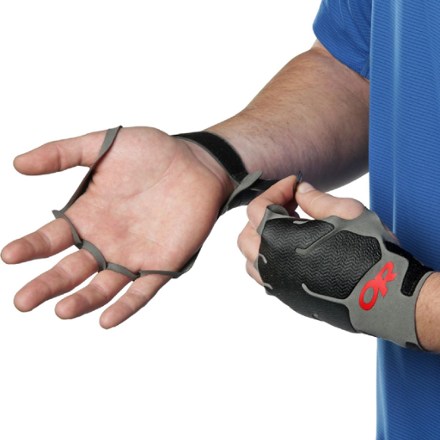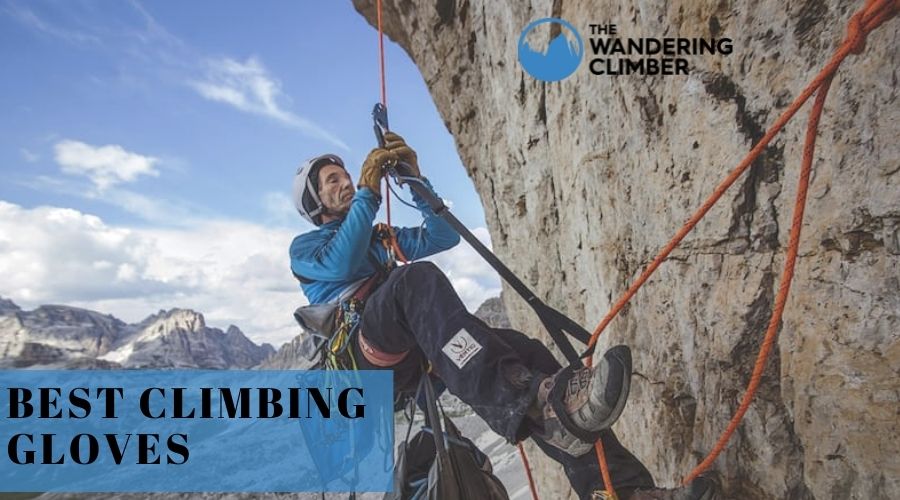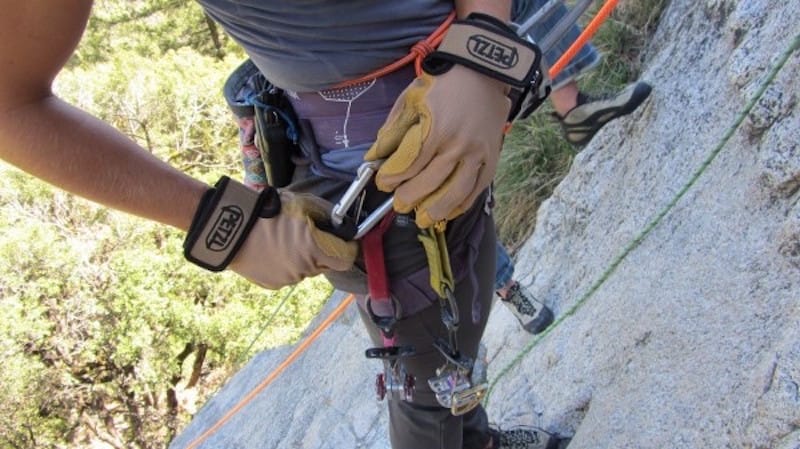*Article Updated As Of April 2024
Climbing gloves are probably one of the lesser known pieces of gear, but one of the most undervalued at the same time.
Of course, the label “rock climbing gloves” can refer to any kind of coverings for your hands worn while at the crag… In this guide, however, we won’t be looking at gloves designed for cold-weather use, but the ones meant for belaying, big wall use (jumaring, rappelling etc.) and crack climbing.
Even if some of us go our whole climbing career without them – and some people consider them a frivolous accessory – a good pair of climbing gloves will do wonders to protect your skin while belaying or doing maneuvers like jumaring and aiding, and it will also give you that extra warmth you need in chilly weather.
If you’re planning to step up your climbing and heading onto trying a big wall, or just tired of having to worry about your skin while belaying or crack climbing, what you need is some good gloves!
We’ve done the research for you and put together a list of the best belay and crack climbing gloves with their characteristics, price-quality ratio, and pros and cons.
In this thorough guide, you’ll find:
Hey! By the way… this page contains Amazon affiliate links. So if you make a purchase after clicking one, at no cost to you, we may earn a small commission. Thanks for your support!
Belay Gloves Buying Guide
Belay gloves come in 2 different versions: full-finger and half-finger gloves. These gloves are not used during the actual act of rock climbing (while they can be, if you want), but, indeed, worn while belaying another climber or carrying out maneuvers on the wall. They can also be a useful accessory for via ferratas.
Full-Finger Climbing Gloves
As you can imagine, the full-finger version covers your whole hand, giving you great protection, warmth and a better grip when belaying or rappelling.
With these on, you will forget about skin abrasion and focus your whole attention on the climber you’re belaying: you will belay better and also break more quickly and easily on a rappel, all of it while keeping your hands nice, warm and safe.
On the downside, these gloves can be expensive and burly to clip to your harness, put on and take off. Also, if you’re climbing in hot weather, they may make your hands sweat too much.
Let’s have a look at some of the best full-finger belay gloves on the market!
- Belay without restrictions: Ergonomic cut offer perfect level dexterity without being too tight
- Long lasting with superior quality leather
- Keep your hands safe: Double layer of leather protects high-wear zones
- Low sweat: Breathable material on back keeps hands fresh
- Easy to carry: Build in carabiner holes make them easy to attach to harness
The Petzl Cordex are the best rock climbing gloves on the market. It boasts a careful and detailed design: a double layer of leather protects the palm side of the glove with extra protection on the thumb and index finger, which is where gloves usually show wear first.
As with the Black Diamond’s Crag, the seams do not sit on the fingertips, so as to increase precision and movement when wearing them.
This version is durable enough, but, if you are afraid you will wear them out too quickly, Petzl makes an extra-durable version of the same glove called Cordex Plus. If, on the other hand, you’d like something lighter for warmer weather, they also make Cordex Lightweight Belay Gloves: a durable leather palm and fingers and a super breathable nylon back.
Petzl climbing gloves are a hybrid, meaning half leather gloves with synthetic in its design. Also, as of April 2024, the price is the lowest its ever been. Make sure to click the link below to get the best price the Petzl Cordex:
- Synthetic Leather
- Imported
- Pull On closure Pull On closure
- Available in women’s specific sizes and colors
- Breathable stretch mesh fabric and knuckle padding
- Synthetic leather palm and fingers with reinforced index finger and thumb crotch for durability
- Hook-and-loop cuff closure with pull-on/clip-in loop
- CE certified to EN 420 and EN 388 (2131)
The Crag Gloves have a great quality-price ratio: made with synthetic leather and highly breathable stretch-mesh, they provide firm grip and a good fit. The seams are well-placed so that they do not hinder finger dexterity and the padding offers great protection and comfort without sacrificing sensitivity.
Black Diamond did a great job with these durable, breathable gloves, and you will like the price, too!
They are also the perfect choice if you’re looking for a vegan friendly product.
- Cowhide main body with triple-stitched, split cowhide palm reinforcement
- Biner clip in loop
- All wear areas are reinforced
- Full-fingered version of the Climbing Glove
- 100% Leather
The Metolius Belay are all-leather gloves, made of smooth and durable cowhide. They can be slightly more pricey than their synthetic or mixed counterparts, but the leather is thicker and will keep your hands warmer in colder temps.
They offer excellent protection, but also have some downsides: they are quite burly and stiff, and might take a while to be broken in properly (and, even then, they are not particularly flexible).
Because of the all-leather design, they are also not the most breathable model and can feel a bit chunky. If protection and durability are your primary concerns, these sturdy gloves are probably worth the price. When trying them on before buying, take into account that the leather will stretch a little bit with time.
As we’ll see later on, they are also available in a half-finger version called Metolius Climbing Glove.
Half-Finger Climbing Gloves
If you don’t like the idea of having your fingers fully covered, or already own a pair of full-finger gloves and want something lighter and simpler for a big-wall adventure (or for the summer!), you’ll need some half-finger climbing gloves.
As the name suggests, these only cover and protect your fingers up to a point (which varies in different models), leaving your fingertips in the air. This design gives you more dexterity, but sacrifices protection.
These gloves are usually simpler, lighter and more comfy to wear and carry, even if they can still be less than ideal to put on and take off (until you get used to them, of course).
You can use them to jumar, rappel and belay. If you are climbing a big wall, they are a lighter and more practical option.
Some even use them in very cold weather to climb easier pitches, so that their whole hand is not in contact with the freezing rock.
Let’s look at some options!
- Goat leather
- Reinforced leather palm and knuckle patches with Kevlar stitching
- Hook-and-loop cuff closure
- CE certified to EN 420 and EN 388 (2142)
The black diamond stone gloves are all about simplicity and perfect for long days on big walls. They’re great rappelling gloves and their all-leather design ensures a great fit and features reinforcements in the high-wear areas.
As fingerless gloves go, they offer good protection, especially in the thumb area. Unlike with some other gloves, you will not really need a break-in period: these fit perfectly straight away, and they will withstand more than you can imagine.
On the downside, they are probably the most expensive half-finger gloves on the market. Even if they do offer some unique features (extra leather extender under the fingers and Kevlar stitching) and a great fit. You will have to decide if they’re worth the price.
- Cowhide main body with triple-stitched, split cowhide palm reinforcement
- All wear areas are reinforced
- Double-stitched finger openings
- Bar-tacked webbing clip-in loop
- Hook and Loop closure
As the full-finger version, these gloves are some of the most durable on the market. Their all-leather construction will withstand abuse on dozens of walls and will keep your hands safe jumaring, belaying, hauling and everything else you’ll do on the rock.
The main problem with the Metolius Climbing gloves is that they can feel quite stiff and might take a while to break-in. Until then, they will be hard and can even feel abrasive for some. In terms of durability, they are the best, but, even when they soften, their fit and comfort are not great. You’ll need to determine what is more important!
- 95% polyester, 5% spandex
- Imported
- Pull On closure
- Machine Wash
- Fabric Performance: Durable, Breathable, Ultra-Tactile, Leather Palm, Split Suede Overlays on Palm and Fingers
Usually, as we mentioned, fingerless gloves sacrifice protection for comfort and dexterity. These Fossil Rock gloves, however, do a great job in both. Their design is faultless and they are a pleasure to wear for long periods of time: they will offer great protection for your skin and you’ll almost forget you’re wearing them.
The clip-in loops are also the largest of all gloves we’ve looked at, which makes them easy to put on, take off, and clip them to your harness. These gloves have a thoughtful design (kevlar stitching and all!) and are durable and breathable: a polyester/spandex blend with a goat leather palm and suede overlays on high-wear areas.
If you have small hands, though, make sure you try them on first, as their fit is quite large.
Non-Climbing-Specific Gloves
Gloves are a useful accessory, sure, but not everyone is willing to pay for a pair of specialized climbing gloves (which can actually be pricey!). If you are on a budget but do not want to sacrifice the skin on your hands, you can always buy non-climbing specific gloves.
Here are the best we’ve found!
- SHRINK RESISTANT: These work gloves are made with synthetic leather, providing toughness, and helps to resist shrinking/hardening. Excellent for outdoor jobs where gloves may become wet.
- SOFT AND COMFORTABLE WORK GLOVES: Protect yourself against many jobs with these durable work gloves by CLC.
- FLEXIBLE SAFETY GLOVES: With stretchable spandex, Lycra side panels for improved dexterity, these work gloves will enable you to do the job without restraint
- WORK GLOVES THAT STAY ON: These work gloves feature an elastic cuff with strap to prevent work safety gloves from slipping off when they become wet
- WORK GLOVES FOR TOUGH JOBS: These CLC work gloves provide excellent protection for construction workers, mechanics, roofers, maintenance workers.
The CLC Handyman gloves are a great budget-friendly choice for climbers. They are described as work gloves designed to maintain the best possible dexterity.
Even if they are not ideal for climbing (after all, they are not rock climbing gloves), they do a good job protecting your hands at the crag. They are made of synthetic leather, stretchy spandex and Lycra and provide a good fit and toughness.
- 100% GRAIN COWHIDE: Superior abrasion and puncture resistance
- DURABLE LEATHER: The reinforced leather palm patch increases overall wear and durability
- ADJUSTABLE WRIST: The adjustable ball & tape style wrist closure keeps out dirt and debris, while also keeping your glove in place
- COMFORTABLE FEATURES: Ergonomically designed Gunn cut and keystone thumb mimic the natural curvature of the hand for added comfort and dexterity
- COMFORTABLE FEATURES: Ergonomically designed Gunn cut and keystone thumb mimic the natural curvature of the hand for added comfort and dexterity
- TRIED & TRUE: Top selling Wells Lamont worksite glove; built to last
Wells Lamont is a specialist in work gloves. Again, these are not gloves made for climbing, but they can do the job if you’re looking for a cheap option and don’t want to buy specific belay gloves.
Most of their models are a mix of leather and synthetic material, water resistant and reinforced in key areas. They usually hold up well to climbing use and can be quite comfortable.
They are not the best, but not especially bad either. If all you’re looking for is to protect your hands while belaying or jumaring, these gloves are cheap, simple, and effective. For the fit, consider going up a size as they can be snug.
If you want half-finger gloves, for the price of these, you can even buy them and cut the fingers off!
Crack Climbing Gloves
Crack climbing gloves, unlike all other gloves we’ve seen until now, are actually worn while climbing. These are gloves that only cover the outside part of your hand, leaving your palm and fingers free, and their purpose is to protect your skin from the rock when jamming your hands into a crack.
Usually, climbers create temporary gloves made out of tape, but in recent years this has started changing and crack climbing gloves have appeared on the market to become the reusable and easy-to-put-on-and-take-off version of good old tape gloves.
If crack climbing is your thing, and you do it (or plan to be doing it) all the time, you definitely need a pair of these, especially if you’re tired of spending time with all that tape handling!
In this case, there isn’t much competition. Let’s have a look at the options!
- Excellent Protection for Jamming, Maintains Sensitivity and Improves Friction, Quick Release Hideaway Strap Closure
- Stop spending 15 minutes reinventing new ways to tape your hands for each project, only to end up with scabby broken hands! Ocun crack climbing gloves are a durable, comfortable solution.
- The microfiber suede stretches to conform to your hands, meaning these lightweight climbing crack gloves aren’t bulky and actually help you climb better than tape or chalk alone.
- Increased feedback and friction from highly sensitive rubber makes jamming such a breeze you’ll wonder where these gloves have been all your life.
- Increased feedback and friction from highly sensitive rubber makes jamming such a breeze you’ll wonder where these gloves have been all your life.
The Ocune gloves are particularly good for rough rock, on which tape might not be enough to protect your hands from the hard crystals. The rubber is quite thick and offers great padding, with an extra strip on the knuckles.
The extra protection is a great feature when it comes to hand cracks, making jamming almost too comfortable! At the same time, though, it substantially reduces sensitivity. If you prefer to always feel the placement of your hands for feedback, these are probably not the best choice.
However, if you like granite cracks but do not love the pain that comes with them, these gloves will change your life! And, if you don’t usually like crack climbing, they might even make you change your mind!
- 100% Other Fibers
- Imported
- Machine Wash
- Fabric Performance: Durable, Ultra-Tactile, Ultra Lightweight
The Splitter Gloves are slightly different to the Ocun as they provide more sensitivity and offer a more natural feel.
The padding is made of synthetic leather, which is thinner and more flexible.

If you like the feeling (and pains) of climbing with tape gloves, these are for you.
Hand jamming will be more precise, and even if you will not have the incredible protection offered by the Ocun, you will certainly have more feedback and control over your jams.
While the previous model is made for rough, uneven rock, the Outdoor Research Gloves perform best on smooth rock, and are more lightweight and less bulky.
If you’re looking for more, both of these appeared on our list of the best crack climbing gloves!
What To Consider When Buying Gloves
We hope this rock climbing gloves guide will make it easier for you to decide which ones you’ll add to your rack! Of course, there are many more good models on the market that we haven’t mentioned, like the Black Diamond Transition or the half-finger version of the Crag Gloves, but this is our list of the best!
But to determine the perfect match of belay and/or crack gloves for your hands, we need to look at your needs and the style of climbing you’ll be doing.
Ask yourself questions like:
- What do I need them for?
- How often will I be using them?
- Do I want to prioritize comfort and dexterity (fingerless gloves) or protection and durability (full-finger gloves)?
- What price am I willing to pay and what materials do I prefer (synthetic or animal leather, breathable or warm)?
Let’s break down some factors to keep an eye on.
Material
So, synthetic leather or animal leather?
Synthetic Leather – cheaper, but will wear faster in the long run.
Animal Leather – animal hide that can be sourced from cows or goats. Cowhide is more durable but stiff, while goat leather is supple and light-weight. This leather will feel stiff, especially when not broken in yet, but can feel really comfortable in hybrid gloves.
Petzl Cordex, a hybrid glove, has both synthetic-materials and leather in its design that maximizes protection and doesn’t compromise comfort or dexterity, and this may be a great combo option depending on your needs.
Quality
Ask yourself if you’ll need gloves that could bear countless climbs, or one that you probably won’t be using that frequently. Because if it is the former, then investing in a good quality pair that’ll last you will be the best bet. But if not, go for an affordable and decent pair instead.
Fit
Most brands have a chart that will allow you to measure your hands and pick the perfect size. As we mentioned, even if most gloves fit true to their size (Black Diamond Crag, Petzl Cordex), some gloves are known to have a tighter fit, like the Ocun and Wells Lamont, while some others are always a bit larger, like the Outdoor Research Fossil Gloves. If you can, going to your local gym and trying them out is a great strategy to see which size/style fits your hands best.
Also, if your friends have a pair, ask them to let you use them for a belay or climbing session before choosing. And note that the right synthetic glove should fit your hand immediately, whereas a leather will stretch with use, so make sure to buy the right size according to material.
Feel
How much do you want to feel the rock? Deciding the sensitivity you want in your glove will aid a lot in deciding which to get; whether that’s with higher dexterity and comfort with a half-finger, or a better grip and protection with a full-finger.
Abrasion-resistant
When talking about abrasion-resistant, we mean a glove that will protect you from hand-abrasions, and it’s quite important. This goes hand-in-hand with the feel because:
- Less abrasion-resistant – thinner, higher sensitivity and dexterous glove
- More abrasion-resistant – thicker, stiffer, less sensitivity and less comfortable.
So, depending on your style of climbing, it’s crucial to find your balance between a good abrasion-resistant glove and one that won’t cost you your climbing ability.
Breathability
Comfortable gloves will naturally give you a better experience when climbing, and finding a pair that offers ventilation can greatly help. There are two main types of materials used with different benefits:
- Synthetic materials – has great ventilation but suffers from the lack of durability
- Leather materials (both synthetic & natural) – poor ventilation, but great durability
Velcro
A good Velcro strap is essential in making sure your glove stays securely in position and won’t fall off mid-climb. The things to keep in mind is the effectiveness of the Velcro, if it’ll easily wear with time, the width of the Velcro strap you want, and how effectively it secures your hands.
Pull-out Straps
Some climbing gloves may have pull-out straps and is not a necessary accessory, but it can help when taking off your gloves. You could also loop this onto your caribiner to carry.
Price
This will vary from the quality you’re looking for and the type of climbing you’ll do with it.
The high quality, heavier-duty gloves will have higher prices that can reach the $40s, but these are usually made using animal leather. Synthetic leathers and materials can have prices half that and still suit your needs, so evaluate what you need first before investing in the right pair for you.
Finger Length
Climbing gloves will either be full-finger length or half-finger, and sometimes 3/4.
Full-finger glove – Provides protection, warmth and a better grip, but it loses the benefit of sensitivity and dexterity. And you can often sweat a lot in them, so not quite comfy in hot environments.
Half-finger glove – Higher sensitivity and dexterity, and more breathable and comfortable. Less protection to exposed fingertips.
Clip-in Hoop
Climbers often need to clip their gloves to their harnesses, so gloves need a hole to clip a carabiner. This usually comes in the form of a hoop, or a hole at the base of the palm.
So, Which to Get?
There are quite a few factors to consider when finding the right gloves for you, but here’s a quick breakdown of some of the best gloves mentioned:
The Metolius (half and full-finger) are designed for heavy use and are the most durable of all. You can spend hours jumaring, hauling and belaying with these on, and they will last forever. If you want a vegan-friendly option, go for the Black Diamond Crag Gloves.
If you’re looking for something lighter and less bulky for big wall use, we suggest the Black Diamond Stone Gloves. They offer the perfect balance between comfort and protection.
For great dexterity and unique features, the Petzl Cordex takes first place, and if what you want is just a cheap pair of gloves to protect your hands from rope abrasion, but are not bothered to buy specific climbing gloves, the Wells Lamont is probably your best budget choice.
If you answer the questions for each characteristic and have another look at the gloves’ description, you’ll know what you’re going for.
Q&A
Which climbing gloves for sensitive skin?
Thicker gloves with higher durability will help protect sensitive skin, like the Metolius and Petzl Cordex.
What size should climbing gloves be?
They should fit perfectly for synthetic-material gloves, while animal-leather gloves should be bought a size smaller, as it stretches with use.
How much do high-quality climbing gloves cost?
This could go up to $30-40 and higher.
Where can I buy climbing gloves?
You can buy these gloves at specialist climbing stores, climbing gyms, or online stores like Amazon.
Should I wear gloves while rock climbing?
You can wear gloves but it’s not essential, and most climbers don’t because it affects their grip, dexterity, and sensitivity.
What are belay gloves for?
Belay gloves (and rappel gloves) help prevent rope burns and abrasions on the skin when handling fast moving rope (a ‘rope glove’, essentially). They also give your hands a break when belaying after a rough sports climb, and keeps the nipping cold out too.
Are belay gloves worth it?
There are people who say it isn’t, but it’s actually quite an important tool. If a slippage occurs on the wall and exceeds the breaking force of the belay device, the rope will slip through the belay and slide through your hand, effectively giving you quite an unpleasant rope burn. So, if you want to avoid that, it’ll be quite worth it.
Do rock climbing gloves grip when wet?
Many of them do have an excellent grip in wet environments. So regardless of the weather condition, you’ll still have a flawless grip.
There You Have It!
With all the information above, you should now be able to get the right pair of gloves and enjoy their use during all your rock climbing adventures.
Long story short?
The Petzl Cordex are hands down the best climbing gloves out there right now.
They’re a perfect mix of dexterity and durability, with a few bells and whistles that make all the difference. And at this discounted price, there’s never been a better time to pick up a pair:
- Belay without restrictions: Ergonomic cut offer perfect level dexterity without being too tight
- Long lasting with superior quality leather
- Keep your hands safe: Double layer of leather protects high-wear zones
- Low sweat: Breathable material on back keeps hands fresh
- Easy to carry: Build in carabiner holes make them easy to attach to harness
For further reading check out our guide for all things rappelling gear!

























